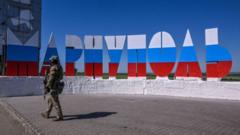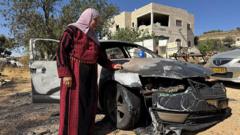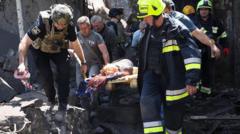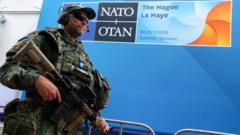While Russian media suggests that life in Mariupol is returning to normal after its occupation, local residents describe a very different reality filled with destruction, shortages, and propaganda. Interviews reveal challenges such as severe water scarcity, dwindling medical supplies, and extensive damage in the city, alongside ongoing acts of resistance against the occupying forces.
Mariupol’s Reality Contrasts with Russian Narratives: Residents Speak Out

Mariupol’s Reality Contrasts with Russian Narratives: Residents Speak Out
Ukrainian residents of Mariupol refute Russian claims of returning normalcy in their occupied city, revealing the harsh realities of living under occupation.
Ukrainian residents of Mariupol are pushing back against the rosy portrayals propagated by Russian media, asserting that the city remains in ruins despite claims of restoration. "What they're showing on Russian TV are fairy tales for fools,” states John, a Mariupol inhabitant, who prefers anonymity due to fear of reprisal. “On main streets, they repair the facades, but just around the corner lies rubble and desolation.” His remarks reflect the prevailing discontent among locals who have endured years of displacement and occupation.
Mariupol, seized by Russian military forces three years ago, experienced cataclysmic destruction during the initial phases of the invasion. It is estimated that 90% of its residential structures were damaged or obliterated. Despite pleas for recognition of their plight, many locals feel their voices are drowned out by a deluge of Russian propaganda painting a characteristically idyllic narrative of urban renewal and revived community life.
Olha Onyshko, a former resident who fled Mariupol last year, echoes these sentiments, stating, “We had a beautiful city, but now it’s diseased." She describes the façade repairs that obscure the grim reality of debris and devastation still typical in many parts of the city. Basics, including water and medicine, are in short supply. "The colour of the water we have is so yellow that boiling it doesn't even make it safe to drink," James, another resident, claims.
As the humanitarian crisis in the city deepens, residents are also facing scrapped medical supplies and soaring prices for basic healthcare. Serhii Orlov, a deputy mayor in exile, highlights the drastic declines in essential services, particularly water provision and electricity.
Conflict extends beyond the physical destruction, emerging in the schools, where children are taught from textbooks laden with disinformation portraying Ukraine's territories as legitimately Russian. “It’s like they are reprogramming the minds of our children,” John observes, referring to the aggressive indoctrination efforts he has witnessed during his time there.
Despite facing a harsh day-to-day existence under Russian jurisdiction, a covert resistance is alive and resisting the narrative imposed by occupiers. Members of resistance networks like James and Andrii work clandestinely to collect intelligence and maintain morale among locals, despite the constant threat of exposure and punitive action from Russian forces.
Every facet of daily life is overshadowed by fear and suspicion. With reports of arrests among suspected informants circulating, both the tension and distrust are palpable. “Every day you have to delete your messages; your phone can be checked at checkpoints,” James reveals, encapsulating the constant state of alert that defines existence in Mariupol.
As discussions surrounding potential peace deals concerning Ukraine and Russia evolve, sentiments among residents lean heavily against conceding any territories. The desire for liberation from occupation far outweighs any desire for a peace that comes at the cost of relinquishing their homeland. John's frustration encapsulates this: “We want liberation, not ‘peace at any cost’." Amidst their struggles, the resilience of Mariupol's residents continues to shine through, casting a light on the true spirit of a city still yearning for freedom.




















